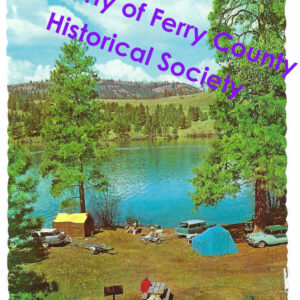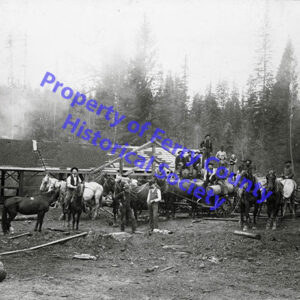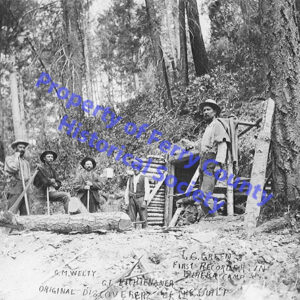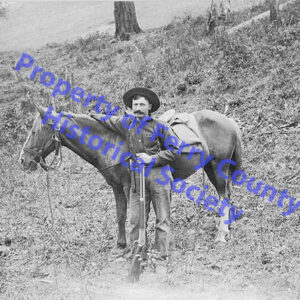New Repository Building Planned
Repository: “A type of facility that is dedicated to managing, preserving, processing, studying, and storing museum property according to professional museum and archival practices”. (Department of the Interior’s Required Standards for Documenting Museum Property) The Ferry County Historical Society needs one. Our collection of Ferry County’s historic artifacts is stored in four different places around town and at least two private homes. None of them provide the heated, lighted work space needed for laying the collection out to be catalogued, cleaned, repaired and used to set up exhibits. In addition, all the owners of our storage spaces have other uses for the room and would like us to gather up our collection and take it elsewhere.
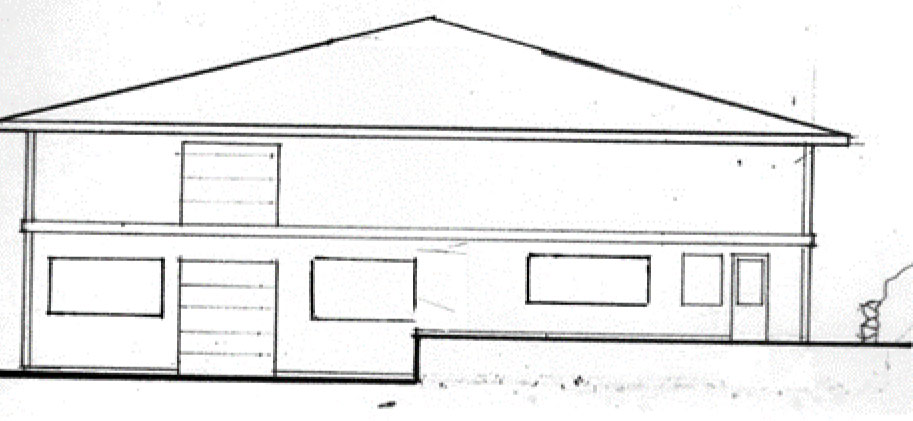
The FCHS Board of Directors has a plan to solve this problem. There will be grant funds available from the state of Washington through the Washington State Historical Society’s Heritage Capital Grants program in 2018 to cover one third of the cost of repository construction up to $750,000. We, the FCHS and the community, will provide the remaining two thirds. Half of the local portion can be in kind, in the form of donated labor and materials. Applying for this grant is a competitive process but we have a good chance because we already own a site for the construction. The former Slagle family garden plot across 9th Street from the J.W. and Elizabeth Slagle house was given to the Society by the family and is big enough for our needs. Members of the Board have consulted with local architect Craig Beener. The sketch below is our preliminary plan for the repository. The estimated cost of the project is approximately $75,000.
The repository will not be solely a storage and preparation facility. Two sides of the structure will have large display windows where the public can see some of our more massive artifacts, such as the six-ton flour mill from Anderson’s Grocery and Flour Mill and the cement mixer that poured many of our business district’s foundations. A combination of repository space, display space, work space and research space will help us to accomplish our mission. A building fund will be established soon at the Coulee Dam Federal Credit Union. Watch the Spring Nugget and the Ferry County View for details.
Visit From Japan to MacDonald’s Grave
Japan’s Rishiri Island High School once again sent two of its student and a faculty member to tour the scenes of Ranald MacDonald’s life and death. This year’s visitors were English teacher Mr. Miyamoto, Yuto Shima and Haruno Tsutsumi. The Japanese Language class from Colville High School accompanied this year’s Japanese visitors. Our Japanese guests were driven up from Spokane by FCHS member Atsumi McCauley.
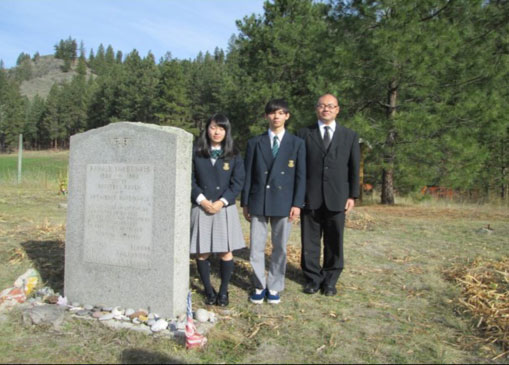
teacher Mr. Miyamoto at Ranald MacDonald’s grave.
Museum Visitors
The visitors to the FCHS Museum in the Fletcher/ Whittaker House for the calendar year 2016 totaled 1049.
This is a very conservative estimate produced by counting signatures in the guest book. In many cases it is impossible to tell how many individuals are represented by a single signature. It was assumed that a plural surname indicated two individuals.
For those signing as a family and not specifying numbers 3 individuals were allowed. Since either sort of “plural signature” could represent more than three people, the actual number of visitors is probably considerably higher. This also does not account for single signatures representing a school class.
Visitors came to us from the following areas: Western Washington, 405 (39%); Eastern Washington 315 (30%); British Columbia, 70; Oregon & Idaho, 60; California, 35; Other Canadian, 15; Iowa, 13; Arizona, 10; Alaska, 9; North Carolina & Indiana, 8 each; Missouri & Maryland, 7 each; Florida, Montana, Nevada, and Virginia were represented by 6 each, Colorado & Wisconsin 5 each; Ohio & Arkansas, 4 each; Georgia, New York, South Carolina, Tennessee, and Texas were represented by 3 each. North Dakota, Oklahoma and Pennsylvania were represented by 2 each. The following areas were represented by one individual each: Washington D.C., Hawaii, Illinois, Massachusetts, Michigan, Nevada, Rhode Island, South Dakota and Utah.
Visitors from outside the North American Continent totaled 20 or slightly over 1% of the total. They came from the following countries: Germany, 5; England, 4; Australia, 3; Japan, 3*; New Zealand, 2. the following countries were represented by one individual each: France, The Netherlands and Taiwan.
*All of the Japanese visitors were members of the party that came from Rishiri Island High School to visit Ranald MacDonald’s grave.
Ferry County Represented at Railroad History Convention
The Great Northern Railway Historical Society (GNRHS) convention, held in Spokane last October, was a success for Ferry County. The Convention was in the planning process for over a year and the Spokane GNRHS members involved have gone out of their way to include Ferry County. The FCHS was invited to participate in the GNRHS “Rail Fair”, sort of a combination swap meet and information clearing house, and was given a free table for a display. Ferry County Rail Trail Partners loaned
The FCHS a folding display with a map of the old GN route. This interested GNRHS members who wanted to know what was being done with the remains of “their” railway. Pamphlets, brochures and bumper stickers were provided by The FCHS, Kettle River History Club, the Husky Car and Truck Museum, Golden Tiger Pathway, Stonerose and the Visitors and Convention Bureau. FCHS members Madilane Perry and Gene Rietzke attended the convention. Perry was invited to give a PowerPoint on “Ferry County Railroad History” and was assisted in putting it together over several months by GNRHS members. Over half of the 200- plus registered convention members were present for the presentation.
The convention’s final event was a three-day “circle tour” following the Great Northern division that ran north from Spokane, looped into British Columbia, ran back down the Okanogan Valley and eventually back to Spokane. The rail line that formerly served Republic’s gold mines was a branch of this division. Perry accompanied the tour which stopped at museums in Hillyard, Chewelah, Colville and Republic and one private home with a collection of railroad artifacts in Kettle Falls. She was able to answer some of the party’s many questions about the area.
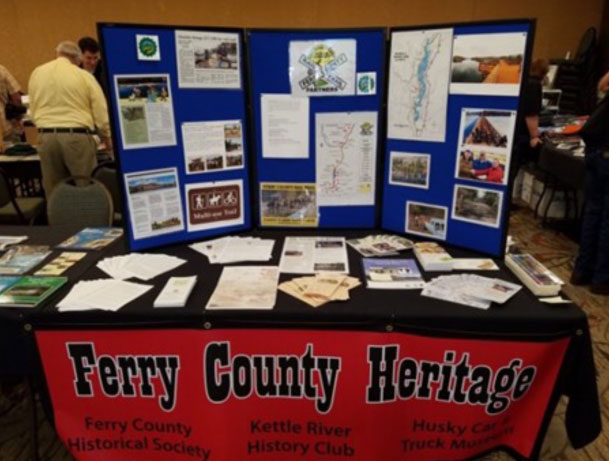
parades and a fair booth, is finally used for the event for which it was designed.
The two buses, carrying 43 people, stopped in Republic overnight, where tour members had dinner “on their own”, had a drink at the Republic Brewing Co., courtesy of FCHS, and retired to the Northern and the Prospector for the night. The Knotty Pine served a buffet breakfast the next morning and the buses continued up the west side of Curlew Lake for a look at the recently surfaced Rail Trail and trestle. The next stop was the Ansorge Hotel in Curlew.
After leaving Curlew, the tour followed the old rail route as far as Toroda where it turned left to avoid the complications of taking so many people into Canada. The tour was scheduled to go to Molson and ended up taking the “scenic route” over Pontiac Ridge. This gave the outof- state visitors the complete rural-Eastern-Washington experience, including slowly following a herd of cattle down the center of the gravel road. All that was missing was a bear.
Molson’s museum is located in the original school building. The former commercial building across the road from the school is now a community center where the museum staff and supporters served the tour members coffee and cake. The tour once again avoided the border near Molson but came so close to it that the Border Patrol was given advance notice that two busses would be in the area.
From a railroader’s point of view, the next stage of the tour may have been the most interesting because the relatively steep, abruptly curved stretch from Molson to Oroville did things railroads don’t usually do. Old time Oroville residents recalled that braking down the steep grade made the locomotive wheels red hot and they could be seen glowing in the dark.
After lunch at the Oroville museum, the buses proceeded down the Okanogan Valley to Omak where the tour spent the night and had breakfast. The next day Included stops at Pateros, Chelan Falls, Rocky Reach Dam and the railroad yard (Appleyard) in Wenatchee. The return trip to Spokane took the tour past railroad sites at Trinidad, Quincy, Winchester, Ephrata, and Odessa. At Harrington, the tour, being a little behind schedule, decided to abandon the rail route and return the rest of the way to Spokane by I 90. The buses came down Sunset Hill just in time to catch the lights of a west- bound train on the Hangman Cr. Bridge.
Download the PDF version of the Fall-Winter Nugget Newsletter

